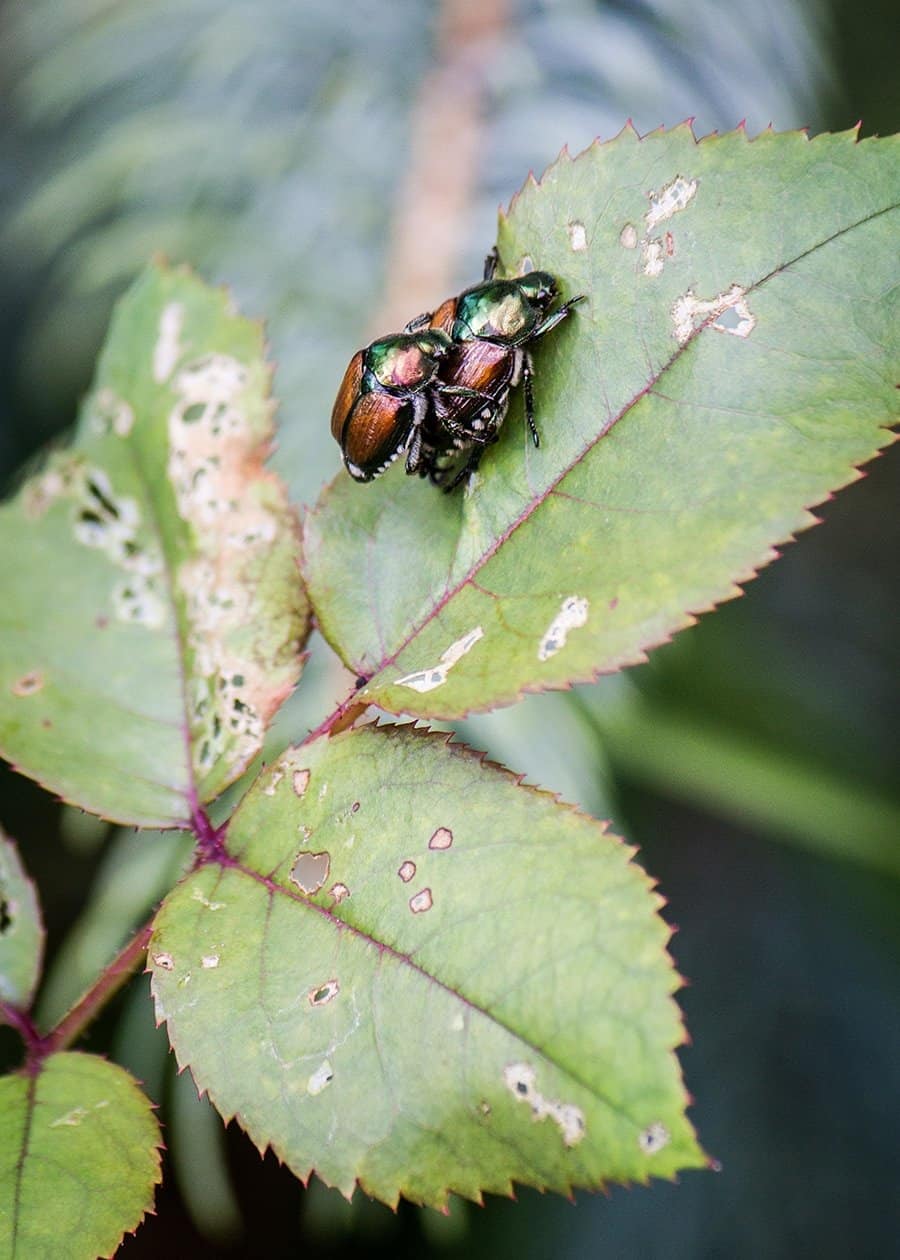
That crunching sound you hear is Japanese beetles making a meal of my roses. It’s hard to do an accurate count on beetles per square foot of garden, but it seems like there are an awful lot of them this summer. Whatever the numbers, their proliferation reflects last summer’s weather conditions when beetles were laying the eggs that hatched this year. There must have been ideal conditions for beetle reproduction, and I wish I kept a weather diary so I could look back and check the temperature and moisture circumstances in August 2012.
I don’t worry so much about Japanese beetle devastation anymore, simply because I’ve given in and accepted that they will satisfy their appetites. Roses are always the first item on the beetle menu. I addressed that problem by planting several early summer-blooming moss roses (‘Salet’, ‘Henri Martin’, ‘William Lobb’, ‘Etna’) that reach peak blossom time before the beetles begin to feed. Now I enjoy flushes of roses up to about the middle of July, when the shrubs enter a green vegetative state and begin making ornamental hips. Rosarians and rose cultivar breeders agree that beetles are attracted to plants with strong fragrance. Any deeply perfumed rose blossom will surely catch beetle attention and be gone by sundown.
The past five years I’ve had a Double Knock Out rose with no scent, and the beetles ignored it and allowed the plant to continue blooming unmolested through early fall. But this year the increased beetle population seems to have a more competitive appetite, and they’re eating the Double Knock Out flowers and foliage, as well as chowing down on the leaves of early non-recurrent roses now out of bloom. As well, I notice they’re beginning to feast on foliage of almost any woody plant in the Prunus genus.
There was some discussion among friends about beetle traps, but none of us had the courage to set them up in our gardens. The fear of drawing Japanese beetles from across the province was just a little too intimidating. The hanging trap bags are baited with potent pheromones, using sex to lure the males into a den of iniquity. But what do you do with a bag full of squirming male beetles, all agitated and looking for a good time? It’s too horrible to think about.
I’d rather be distracted by the booming earwig population that enjoyed perfect conditions (warmth and lots of soil moisture in late June) when eggs were hatching in their nests. All of them survived infancy and are swarming through the garden at night, feeding in the dark hours when Japanese beetles are sleeping. What a perfect partnership these two garden marauders have found in each other!

On the advice of an elderly farmer, I add the dry skin of an onion to the seed potatoes when I plant them. I save the dry onion skins over the winter. I have done this for fifteen years and have not had a potato beetle.
You can look at historical weather data at the Weather Network.com.
Select “Forecasts”, then under “Special Reports”, choose “Historical Weather.”
I wish everyone would attempt to collect the Japanese beetles to at least reduce their population. In addition to my roses, they love my cannas, Cracker Jack marigolds and morning glory vine. I don’t bother with soapy water, I just put some hot water in a small plastic container and knock them in, put the lid on, and set in the sun. The pheromone traps draw 100’s of them… I won’t use them again.
The only thing that Japanese beetles ever touch in my garden is porcelain berry vine (Ampelopsis). There’s a brief but intense infestation and then they are gone. Three weeks later you’d be hard pressed to notice they’ve even been as the vine quickly sprouts new growth. As a result I don’t bother trying to control them at all. And their single-mindedness as to preferred host means they avoid everything else. But, yes: there were a few on the ornamental cherry this year – but very few.
During the last two years I have tried to combat the Japanese beetle invasion with different methods with very little success:
– picking by hand and drowning in soapy water
– using beetle traps – the raccoon ripped apart
– planting geraniums – apparently the beetles like to feed on but they are paralyzed for hours and can be collected.
In June my roses flowered and looked beautiful.
After the arrival of the Japanese beetle my roses where attacked again.
I made a decision, cut my rose bushes and removed them from our garden. Right now I am checking my flowering Rose of Sharon for the beetle.